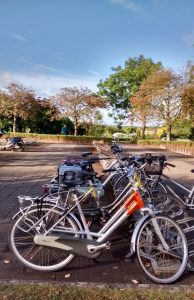By Halina Brown.
The bicycle of today is amazingly similar to its 1886 forbearer. The innovations over the ensuing 130 years — gears, breaks, new materials and manufacturing processes – have not changed its iconic shape and the relationship between the machine and its user: sit down on the saddle, put your hands on the handlebars and pedal to move forward. The stamina and motivation of the rider determine who uses a bike and how far they can go. But this is all about to change. There is a revolution in the air in personal mobility in the form an electric bicycle. It has a potential to greatly reduce the use of cars. I witnessed its beginnings during my recent visit to the Netherlands.
It is quite appropriate that the shift toward e-bikes would occur in the Netherlands, a country with a deep love affair with a bicycle. Simply put, the Netherlands is a biker’s paradise, both for long distance athletic bikers and, more importantly, for those who use it as a primary mode of personal mobility in everyday life and as a form of leisure and recreation. Nearly a third of all trips in the NL are made on bicycle.
There are several reasons for the popularity of bikes: high population density, short distances, flat terrain in most parts of the country, and cool summers and mild winters. But the biggest factor is the remarkable infrastructure, carefully developed and maintained by local and central governments. Many roads include one or two separate bike paths (fietspad) complete with their own system of traffic signals. The Netherlands has 35,000 kilometres (22,000 miles) of separate dedicated bicycle paths. When a bike road meets a car road there are dedicated bike crossing points, including roundabouts, with the right of way given in most cases to bicycles. The countryside, recreational parks, and large private estates are crisscrossed with bike paths. Recently, several high-speed dedicated bike roads have been built for long distance biking. Basically, I cannot imagine any place that cannot be reached and enjoyed with a bicycle. And along with the paths, there is an abundance of other support: garages, repair shops, ways to transport a bike on public transit, and so on.
The result is that in smaller cities streets are quiet, clean and peaceful – an extension of people’s homes, not simply thoroughfares for motor traffic. The variety of people biking in the Netherlands is extraordinary: parents with children, sometimes one on the front, one in the back, even kids standing on luggage racks and holding nonchalantly on to the cycling adult’s shoulders, unassisted school children, office workers dressed for work, older people chatting while biking side by side, shoppers, and groups of teenagers. And on sunny weekends people come out in masses, everywhere. Essentially, the daily life of Dutch families is on display while biking. No helmets, no special athletic clothing. Biking is part of the daily routine, and people obviously feel safe. The latter is helped by the country’s strict liability laws – in a collision between a faster, larger vehicle and a slower, more vulnerable one, the former is found liable by default, unless its driver can prove otherwise. Those on foot are protected from cyclists and both are protected from motor vehicles.
So why this sudden surge of e-bikes? Electric bicycles have been around for decades, but technological advances have made them user-friendly and affordable. Commuters and the elderly are embracing it. During my recent stay in the Netherlands, I checked out the bicycle parking lot in front of the local indoor swimming pool facility. It was a weekday morning when the pool is mostly populated by retirees. More than half of the bikes were electric. These are the people who until now might be thinking of giving up bicycling and become dependent on a car. The e-bike has given them a renewed personal mobility at a low carbon footprint, with the gentle breeze in their hair as a bonus. Both the people and the environment are the winners.
Now I am back in the U.S., feeling envy over the Dutch biking infrastructure. Hopefully, in a few years, we will make progress on that count. I might then consider buying an e-bike for these long hilly treks to do my daily errands in Massachusetts.


 A few blocks south of Penn Station — the main intercity railroad in New York City — there is a housing development known as Penn South. Its formal name is Mutual Redevelopment Housing. It is a limited equity cooperative development in the Chelsea area of Manhattan. Built in 1961 by the International Ladies Garment Workers Union, with an invaluable support from the City of New York, this cluster of ten 24-story high buildings houses 2820 apartment units for moderate and low-income residents. Monthly charges are about one-third of market rates. And like all very dense urban conglomerations, the greenhouse footprint of the residents is much smaller than in sprawling car-dependent suburbs with large single family houses.
A few blocks south of Penn Station — the main intercity railroad in New York City — there is a housing development known as Penn South. Its formal name is Mutual Redevelopment Housing. It is a limited equity cooperative development in the Chelsea area of Manhattan. Built in 1961 by the International Ladies Garment Workers Union, with an invaluable support from the City of New York, this cluster of ten 24-story high buildings houses 2820 apartment units for moderate and low-income residents. Monthly charges are about one-third of market rates. And like all very dense urban conglomerations, the greenhouse footprint of the residents is much smaller than in sprawling car-dependent suburbs with large single family houses.